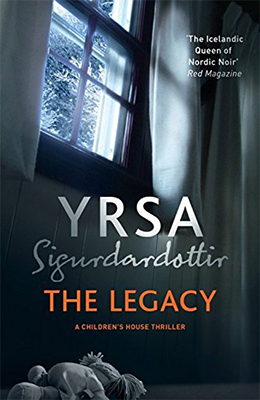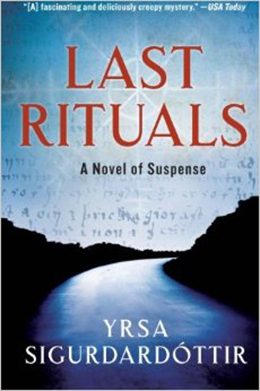From the Booking Desk:
Yesterday, I posted my review of Yrsa Sigurdardóttir’s new series debut, The Legacy. Today, I am happy to welcome her to BOLO Books for some deeper discussion of this new novel, translations, how the Paleo diet is like a ghost, and the possibility of Thóra making an appearance in the new series. You don’t want to miss this folks!
BOLO Books: The Legacy is the start of a new series for you. Rather than centering the series around a particular character, this book is being called A Children’s House Thriller. Can you tell us about The Children’s House and the decision to focus a series on it?
Yrsa Sigurdardóttir: The Children’s House is an actual institution, operated in Iceland for the benefit of children that are victims of crime, in most part victims of abuse. The institution serves to lighten the burden such occurrences thrust upon children, by conducting all required investigative and judicial processes within a single, child-friendly location. The institution has a medical facility where doctor’s examinations take place if required and psychologists specialized in interrogating children handle the questioning on behalf of the police, as well as the judicial system when the cases go to trial. This questioning takes place via CCTV cameras or two way mirrors so that the child does not have to face the police, a judge or the accused. Instead the child sits with the psychologist and discusses while the questions are fed to the latter via an earpiece. The questions are then reworded by the trained specialist or set up in a way that will not lead the child on. This is a crucial factor of the operation as child witnesses tend to reply by stating what they think the grown-up asking the questions wants to hear. Since its opening, the Children’s House has been a great success and other countries have taken up the same system.
I decided to use the Children’s House as a central point for my new series because I found it such an intriguing institution and believed it would provide a basis for stories that would be captivating and interesting for my readers.
 BOLO Books: This is not to say that there are not focal characters. In The Legacy, two of them come to the forefront. First, tell us a bit about Detective Huldar.
BOLO Books: This is not to say that there are not focal characters. In The Legacy, two of them come to the forefront. First, tell us a bit about Detective Huldar.
Yrsa Sigurdardóttir: Huldar is a policeman who in the first book is promoted to lead the investigative department. He feels a bit out of his depth, hates the administrative duties that come with the job and would rather be a regular detective again. He is a bit of a womanizer but has gotten tired of the revolving door leading to his bedroom and would like to establish a proper relationship. This however turns out to be more difficult than he had anticipated. As he tries to focus on the investigation his past behavior does its damndest to interrupt him.
BOLO Books: Reader’s main point of contact at the Children’s House is Freyja. What can you tell us about her?
Yrsa Sigurdardóttir: Freyja is a children’s psychologist, specialized in the questioning technique used at the Children’s House and presently the head of the institution. She is recently single after a break-up and living in her brother’s apartment while trying to find her own place. Her brother is in prison but she hopes against all reason that he will soon redeem himself. Until then she is stuck with his dog.
BOLO Books: Since I know that at least one other book in the series has been written (awaiting translation), can you tell us if these characters reappear?
Yrsa Sigurdardóttir: To date three from this series have been published in Iceland. Huldar and Freyja are both central characters in these books, as well as in the fourth I am about to embark on.
BOLO Books: For those of us who are fans of Thóra Gudmundsdóttir – the heroine of your previous series – might there be a chance of her appearing, even briefly, in one of the Children’s House books? Thóra certainly exists in the same “universe” and I can see her possibly having insight into one of those investigations.
Yrsa Sigurdardóttir: I hadn’t planned on having her make an appearance but in some part because I had not even realized this was an option. Now that the seed has been planted, who knows?
BOLO Books: I know I would love to see her show up, even for just a cameo appearance. I suspect other Thóra fans would feel the same way.
You have also written a number of successful stand-alone novels. How do you approach the writing of them differently?
 Yrsa Sigurdardóttir: Writing a stand-alone novel is very different from writing a series. It has its pros and cons. You start from scratch so you are not bound by anything that has previously been written but you must then invest more into establishing the characters and the premise. The biggest pro for me however is the fact that everyone in a stand-alone is disposable so you as the author are free to do whatever you want with your cast. They are not coming back.
Yrsa Sigurdardóttir: Writing a stand-alone novel is very different from writing a series. It has its pros and cons. You start from scratch so you are not bound by anything that has previously been written but you must then invest more into establishing the characters and the premise. The biggest pro for me however is the fact that everyone in a stand-alone is disposable so you as the author are free to do whatever you want with your cast. They are not coming back.
BOLO Books: One of your stand-alones – I Remember You – features elements of the supernatural. I get the sense that Iceland has a long tradition of ghost stories. Would that be accurate?
Yrsa Sigurdardóttir: Hell yeah, ghost stories have been told here since settlement. The dark winters and crooked landscape sculpted by the endless lava formations, beg the imagination to throw off any shackles of rationality and enter the shadows. In modern Icelandic society the fear of ghosts is in no way as widespread as it used to be, but as a concept the unknown remains superb. The thing is that everything modern man rationally fears can be mitigated down to almost nothing. We can to take steps to avoid and circumvent most of the things we fear. But ghosts do not follow any rules or fit into risk assessment matrixes. If they come after you there is no reasoning with them or the situation. So as a result they incite real fear, the basic fear of being steamrolled by something awful without being able to lift a little finger to avoid it. Fear similar to when people were cavemen, i.e. when human existence was only about staying alive and reproducing. So similar to the paleo diet, it is nice and healthy to be scared by a good ghost story or horror movie now and again. Even though we know such scares make no sense. It simply beats worrying about how many likes your latest photo on social media will get or being afraid of second hand smoke.
BOLO Books: Obviously, your books are originally written in Icelandic and later translated. Tell us a bit about the translation process. Do you consult with the translators?
Yrsa Sigurdardóttir: I have a very good rapport with most of my translators, especially the ones that have remained a constant over many books. In my mind there always needs to be dialogue since the books are originally written for an Icelandic audience so there will be things that I must explain for the foreign reader while the Icelandic one doesn’t need the info. My English readers are very lucky when it comes to the English translations of Victoria Cribb. She is simply fantastic.
BOLO Books: The number of crime authors from the Nordic regions who are translated continues to grow and their success seems to know no bounds. What do you think it is about those counties that readers are connecting with?
Yrsa Sigurdardóttir: I think the appeal and popularity of Nordic Noir is a multifaceted beast. In part it has to do with the sparse writing style that is traditional here and seems to fit crime fiction pretty well. It also relates to our fascination of social injustice and injustice in general. You are not from Scandinavia if you don’t ponder on these issues at least 25% of your thinking time and 33% of the time when dreaming. So, as you can imagine such topics will of course make their way into the fiction coming out of the Nordic countries. On top of these two things there is our liking of antiheroes and bungling, messed up people, which in crime fiction would be the defective detective that often features prominently. Finally we have the snow going for us. Snow that is usually on Nordic Noir covers speckled with blood, as red on white is super striking, albeit less so than yellow on black according to color theory. Someone should try starting a crime fiction sub-genre of Formula One murder mysteries and see how that sells.
 BOLO Books: I first met you at a Bouchercon – just after Last Rituals was published in the U.S. You are a regular attendee at these mystery conferences – Bouchercon, Malice Domestic, Iceland Noir, etc. Tell us a little about your experience with them – both personally and professionally.
BOLO Books: I first met you at a Bouchercon – just after Last Rituals was published in the U.S. You are a regular attendee at these mystery conferences – Bouchercon, Malice Domestic, Iceland Noir, etc. Tell us a little about your experience with them – both personally and professionally.
Yrsa Sigurdardóttir: I thoroughly enjoy going to the various mystery conferences and would go to them all if only I had the time. They provide one with the opportunity of meeting so many readers as well as fellow writers, something that isn’t an everyday occurrence. You can’t go wrong in spending a weekend surrounded by people who come together for their love of books and reading.
BOLO Books: If forced to choose only one format for all your future reading, which would you choose: Hardback, trade paperback, mass-market paperback, or e-book? And why?
Yrsa Sigurdardóttir: I think it would be trade paperback. I actually like hardbacks the most, but they are harder to travel with and I can’t go on a plane without a book or stay in a hotel so they are pretty much out in the scenario you present. I am not a super-fan of mass market paperbacks so this format is out. I always suspect that material has been cut from the text to fit the format, although I know full well that this is not true. And e-books, well I just haven’t managed to get used to e-readers. I like the book in my hand to be made of paper, not aluminum.
